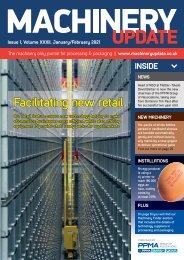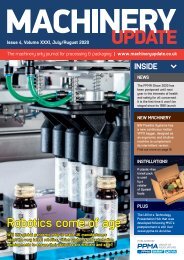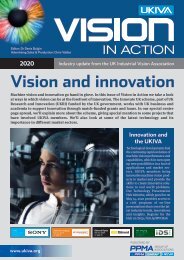Vision in Action Autumn 2019
Create successful ePaper yourself
Turn your PDF publications into a flip-book with our unique Google optimized e-Paper software.
PRODUCT UPDATES<br />
29<br />
SONY IMAGE SENSING SOLUTIONS<br />
www.image-sens<strong>in</strong>g-solutions.eu<br />
Polarised SDK adds w<strong>in</strong>dscreen-glare<br />
removal function for ITS toll<strong>in</strong>g /<br />
enforcement applications<br />
Sony Europe’s Image Sens<strong>in</strong>g Solutions has announced the availability of a w<strong>in</strong>dscreen<br />
glare-removal application for ITS applications via the XPL-SDKW software development<br />
kit for its XCG-CP510 polarised camera modules. Traffic cameras have been shown to<br />
deter dangerous driv<strong>in</strong>g habits, yet glare significantly limits their effectiveness.<br />
The application has been created to improve road safety through ITS enforcement<br />
and toll<strong>in</strong>g applications, for example track<strong>in</strong>g seatbelt and mobile phone use; or more<br />
reliably identify<strong>in</strong>g a driver caught by speed and red-light cameras.<br />
The XCG-CP510 is the <strong>in</strong>dustry’s first polarised camera to feature an SDK. It is based<br />
on Sony’s newly developed IMX250MZR global shutter CMOS sensor, which uses<br />
monochrome quad polarised filters to capture polarised light <strong>in</strong> four planes. The camera<br />
outputs 5.1 MP polarised B/W images at 23 fps, transmitted over a GigE <strong>in</strong>terface. The<br />
SDK enables system <strong>in</strong>tegrators to significantly cut development cost and time when<br />
creat<strong>in</strong>g applications us<strong>in</strong>g polarised modules.<br />
XCG-CP510 camera<br />
STEMMER IMAGING<br />
www.stemmer-imag<strong>in</strong>g.co.uk<br />
B<strong>in</strong> pick<strong>in</strong>g technology broadens subsystem<br />
capabilities for Industry 4.0<br />
With the recent acquisition of Infaimon S.L., a lead<strong>in</strong>g provider of software and<br />
hardware for mach<strong>in</strong>e vision and robotics, Stemmer Imag<strong>in</strong>g has extended its ability to<br />
supply subsystems for smart factories and Industry 4.0. The Infaimon InPicker 3D b<strong>in</strong><br />
pick<strong>in</strong>g system can use a variety of 3D imag<strong>in</strong>g techniques such as passive stereo, active<br />
stereo or laser triangulation to recognize and determ<strong>in</strong>e the position of objects randomly<br />
piled up <strong>in</strong> a conta<strong>in</strong>er and directly <strong>in</strong>terface with a variety of robots.<br />
It identifies the best candidate for pick<strong>in</strong>g, determ<strong>in</strong>es the 3D pick<strong>in</strong>g coord<strong>in</strong>ates<br />
and sends them to the robot. A work<strong>in</strong>g example will be shown at the Stemmer Imag<strong>in</strong>g<br />
UK Mach<strong>in</strong>e <strong>Vision</strong> Technology Forum, 13-14 November <strong>2019</strong>.<br />
InPicker is especially suitable for the extraction of complex objects with very irregular<br />
shapes and multiple structures. It can also identify and extract textured items, such as<br />
boxes of any type of product or metal and plastic parts, allow<strong>in</strong>g depalletis<strong>in</strong>g of ordered<br />
or random objects. The InPicker software also allows the robot to move without collid<strong>in</strong>g<br />
with its surround<strong>in</strong>gs, the conta<strong>in</strong>er or the pieces to be extracted. Fast pick<strong>in</strong>g times<br />
without errors or <strong>in</strong>terruption lead to a swift return on <strong>in</strong>vestment.<br />
InPicker<br />
WENGLOR SENSORIC<br />
www.wenglor.com<br />
S<strong>in</strong>gle software package for three product<br />
families<br />
The uni<strong>Vision</strong> 2.1 central software platform can evaluate both images and height profiles<br />
from smart cameras, vision systems and control units with 2D/3D profile sensors. Users<br />
can create a f<strong>in</strong>ished vision application <strong>in</strong> just a few steps and without programm<strong>in</strong>g<br />
knowledge. The flexible comb<strong>in</strong>ation of <strong>in</strong>dividual hardware components us<strong>in</strong>g a shared<br />
software platform significantly reduces costs as well as <strong>in</strong>stallation and tra<strong>in</strong><strong>in</strong>g<br />
requirements.<br />
The uni<strong>Vision</strong> software is structured like an <strong>in</strong>telligent toolbox. The algorithms for<br />
images and height profiles are similar and can be used on different platforms. The<br />
measurement module runs on smart cameras, as well as vision systems. Up to 25<br />
different software modules are available (e.g. measurement, threshold value, cluster,<br />
OCR, pattern match<strong>in</strong>g, track<strong>in</strong>g etc.), as well as 14 different templates (e.g. read 1D<br />
codes, presence check, detect pattern or detect colour), depend<strong>in</strong>g on the hardware<br />
selected.<br />
Uni<strong>Vision</strong>_2-1<br />
www.ukiva.org

















